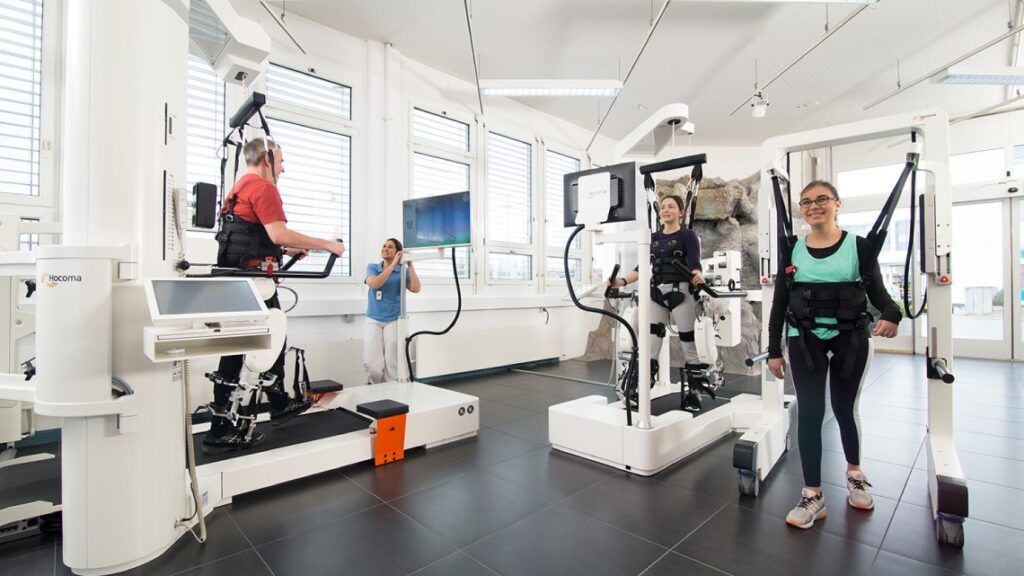In the realm of neurorehabilitation, innovative technologies like the Hocoma Lokomat® have revolutionized the way patients regain mobility and independence after neurological injuries or disorders. Developed by the Moody Neurorehabilitation Institute, the Hocoma Locomat is a cutting-edge robotic exoskeleton that assists individuals with gait training and rehabilitation. Let’s delve into how this groundbreaking device works and its impact on the rehabilitation process.
Robotic Assistance for Gait Training
- Exoskeletal Design: The Lokomat® features an exoskeletal design that wraps around the patient’s lower limbs, providing support and stability during gait training sessions. The robotic structure is adjustable to accommodate individuals of varying heights and leg lengths.
- Dynamic Body Weight Support: One of the key features of the Lokomat® is its ability to provide dynamic body weight support. This feature allows therapists to customize the amount of weight-bearing assistance provided to patients based on their specific needs and abilities.
- Precise Movement Control: Equipped with advanced sensors and motors, the Lokomat® delivers precise and controlled movements to guide the patient’s legs through a natural walking pattern. This robotic assistance helps patients relearn proper gait mechanics and muscle activation patterns.
Integrated Virtual Reality and Feedback Systems
- Virtual Reality Environment: The Lokomat® incorporates virtual reality technology to create immersive and engaging environments for patients during therapy sessions. Virtual landscapes and scenarios are projected onto a screen in front of the patient, enhancing their motivation and focus during rehabilitation.
- Real-Time Feedback: Throughout the training session, the Lokomat® provides real-time feedback to both the patient and therapist. Visual and auditory cues indicate aspects of gait performance, such as step length, symmetry, and weight distribution, allowing for immediate adjustments and corrections.
- Data Collection and Analysis: The Lokomat® gathers extensive data on the patient’s gait parameters and performance metrics during each session. This data is then analyzed by therapists to track progress, identify areas for improvement, and adjust treatment plans accordingly.
Personalized Rehabilitation Programs
- Tailored Treatment Plans: Therapists at the Moody Neurorehabilitation Institute work closely with patients to develop personalized rehabilitation programs using the Lokomat®. Treatment plans are tailored to address each individual’s unique goals, challenges, and level of function.
- Progressive Resistance Training: As patients progress in their rehabilitation journey, the Lokomat® can be programmed to provide progressively challenging gait training exercises. This approach helps patients build strength, endurance, and confidence in their walking abilities over time.
- Multidisciplinary Approach: Rehabilitation with the Lokomat® is part of a comprehensive multidisciplinary approach to neurorehabilitation at the Moody Neurorehabilitation Institute. In addition to robotic-assisted gait training, patients may also receive physical therapy, occupational therapy, and other supportive services to optimize their recovery outcomes.
Advancing Neurorehabilitation Outcomes
The Hocoma Lokomat® represents a significant advancement in neurorehabilitation technology, offering patients with neurological injuries or disorders the opportunity to regain mobility, independence, and quality of life. By harnessing the power of robotics, virtual reality, and personalized therapy, the Lokomat® by the Moody Neurorehabilitation Institute is paving the way for transformative outcomes in neurorehabilitation.
You may also like
-
Coming Clean About DUI Counseling: Making Sense of Alcohol Addiction Awareness
-
What are some of the key differences between traditional saunas and infrared saunas in terms of their health benefits and effectiveness?
-
Exploring Cannabis Stores in Ottawa: Your Guide to Finding the Perfect Marijuana Dispensary
-
Safety and Efficacy of Online Purchasing of Sleeping Tablets
-
Composite Fillings: An Aesthetic Combination Of Luxury And Durability
 Risk Takers’ Playground: Navigating the Highs and Lows of Hedge Fund Hype
Risk Takers’ Playground: Navigating the Highs and Lows of Hedge Fund Hype  Learn More About Binance
Learn More About Binance  Mastering the Stock Market: Insights from a Professional Investor – Kavan Choksi Professional Investor
Mastering the Stock Market: Insights from a Professional Investor – Kavan Choksi Professional Investor 

